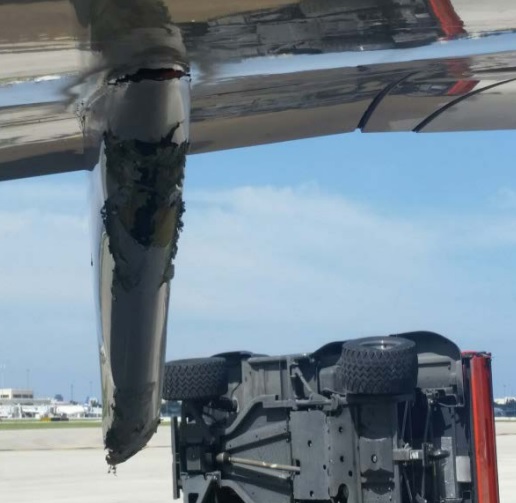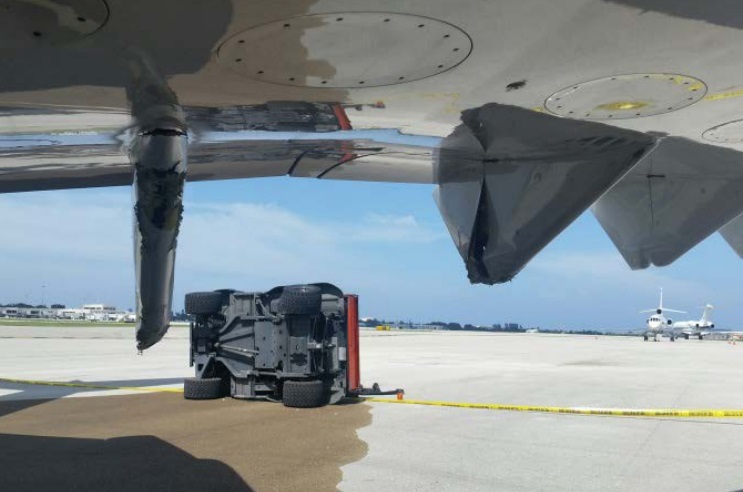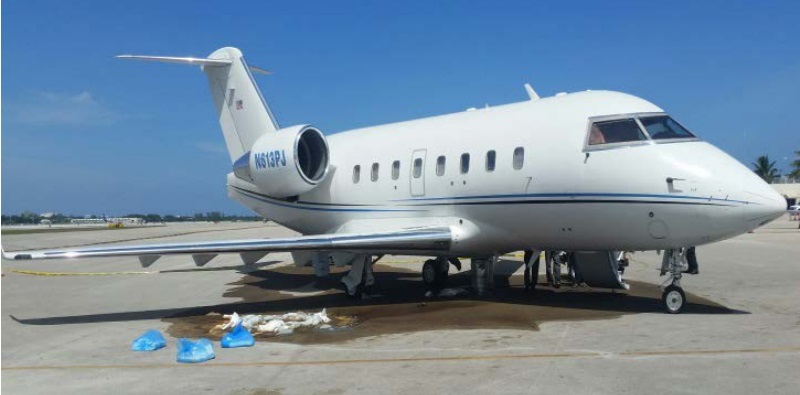Ground Collision Under Pressure: Challenger vs ATV: 1-0
Bombardier CL-600-2B16 Challenger N613PJ, operated by Paragon Jets, ran over an all-terrain ground vehicle (ATV) at Palm Beach International Airport, Florida on 22 July 2015.
Under Pressure
The US National Transportation Safety Board (NTSB) describe in their final report that:
According to the captain, the flight crew was under pressure from the operations department to continue to southern Florida to complete their flight and pick up customers that were waiting.
In the telephone interview with the captain he said:
…this aircraft has a long history of maintenance items and intermitted [sic] lights and warnings that have taken several months to correct and some still existing today.
The aircraft had been in West Palm Beach for repairs after earlier defects. On the day they had:
…waited for the flight attendant to show up and later found out that she drove down to southern Florida to meet that aircraft at the airport were the passengers were waiting.
However, the Captain did not apparently feel that rushed that according to the co-pilot while she was “in the aircraft performing the checklist” he interrupted to ask “if she wanted to fly in the left seat”.
Review of the CVR data did not reveal any tasks associated with the formal prestart checklist being completed. The CVR recorded a conversation about programming the flight management system and then it recorded the captain asking the first officer if she wanted to fly from the left seat. One minute later the first officer replied that she did want to fly from the left seat. The recorder then captured a conversation of an informal checklist usage along with a departure briefing. Two minutes later the recorder captured sounds consistent with both engines starting…
Regular readers, with the added benefit of hindsight, will have recognised a number of threats and no doubt be wondering: What happened next?
Ground Crew Intervention
Two ground handlers, a supervisor and a trainee had noticed that the baggage door was open. They boarded an ATV and drove out to the aircraft…
…parking about 10 feet in front of the left wing. One of the ground handlers then dismounted the ATV and proceeded in front of the airplane while motioning to the flightcrew in the cockpit that the baggage door was open. The captain then remembered that he forgot to close the baggage door and got up to go back and close the door.
The door had been open anticipating the Flight Attendant arriving with luggage.
Collision
According to the Captain’s interview:
Once closed he returned to his seat, on the right side, buckled his seat belt and picked up the checklist to start from where he left off.
The NTSB say that “shortly after, the airplane began moving forward”:
The ground handler then attempted to gain the attention of the pilot seated in the left seat, but was unsuccessful as that pilot never looked up. The airplane’s left wing then struck the ATV before it came to a stop.
On the flight deck, the Captain “looked out the side window and noticed the plane was rolling forward”. The CVR had recorded:
…sounds consistent with switch manipulation and shortly after the captain asked “what are you doing” with an immediate sound of a warning or alert tone as the captain stated, “no brakes….what are you doing?” the first officer responded, “ah I didn’t do anything. What’s going on? What is going on? Stop.” The captain replied, “I don’t know.” Then the CVR recorded sounds of engines shutting down, followed by one second later a sound consistent with a collision. At that time, they heard a noise and bounce in the aircraft and thought they ran over a wheel chock. The Captain stated he was pushing very hard on the brakes and the plane would not stop, he stated they both made several attempts to stop the aircraft and applied maximum brake pressure but it would not stop. The Captain then reached over with both hands and shut down the engines at the same time the First Officer released and re-applied the parking brake. The Plane then came to a stop.
The aircraft’s left wing was damaged and the ATV was overturned. There were no injuries. An FAA Inspector reported:
The puncture resulted in a fuel spill estimated to be about 300 gallons of Jet-A. There was additional damage to at least three of the L[eft] wing flap hinges or fairings and the L MLG door, in addition to several scrapes and rubs at various points under the L wing and flap.
The NTSB note that according to an FAA inspector:
A postaccident functional check of the airplane’s hydraulic and braking systems did not reveal any anomalies.
This is however disputed by one party who we understand has subsequently reported to the NTSB that hydraulic problems also occurred on the next flight. There is unusually a suspiciously large redaction on the FAA inspectors report too.
NTSB Analysis
Review of the airplane’s cockpit voice recorder revealed that the crew did not verbally follow the airplane’s before start checklist, which required them to verify hydraulic system pressure, and that the parking brake was set before starting the engines. Had the flight crew followed this procedure, monitored the airplane’s motion during and immediately after the engine start, and been more cognizant of the objects surrounding the airplane, it is likely that the ground collision would have been avoided.
NTSB Probable Cause
The flight crew’s failure to properly use the before start checklist, to monitor the airplane’s motion, and to see and avoid objects around the airplane, which resulted in an inadvertent roll into a ground vehicle.
Contributory Factors
The NTSB don’t identify any contributory factors but pressure (some external and some perhaps self-imposed), last minute changes of plans and distractions (again at least partly self-imposed) appear to be credible human factors.
Other Safety Resources
We have previously discussed: Business Aviation Compliance With Pre Take-off Flight Control Checks Another accident where take-off checks were shown to be inadequate was: Gulfstream G-IV Take Off Accident & Human Factors We have recently written about another, far more dramatic CL-600 Challenger accident in the US during a delivery flight: Unstabilised Approach Accident at Aspen
UK AAIB Report on Two Ground Collisions
UPDATE 17 July 2017: S-92A Collision with Obstacle while Taxying
UPDATE 10 August 2017: A320 Rolls Back on Stand: Incomplete Maintenance Procedures and Ground Handling Deviations: The brakes had been set OFF during maintenance trouble shooting and the chocks removed prematurely, so the aircraft rolled when a tug with a u/s radio was being swapped out.
UPDATE 14 January 2018: A320 Collided with Two De-Icing Trucks: Misinterpretation of communication due to a lack of standardised phraseology was a factor this incident say the BFU, when an A320 attempted to to return to stand after a checklist error.
UPDATE 25 January 2018: Jetstar Dispatcher Forced to Run After Distracted Pushback A dispatcher was forced to run when an aircraft started to taxi while he was still connected to it after the crew became distracted, skipped procedural steps and misidentified the dispatcher.
UPDATE 22 April 2018: A330 Starts to Taxi Before Tug is Clear ATSB say misunderstandings by the parties involved led to incorrect expectations and the aircraft beginning to taxi prior to the tug moving clear.
UPDATE 7 July 2020: The pilot petitioned for a review of the NTSB report. This review determined no change was necessary.
UPDATE 8 July 2020: Challenger Damaged in Wind Shear Heavy Landing and Runway Excursion
UPDATE 12 October 2020: Runaway Dash 8 Q400 at Aberdeen after Miscommunication Over Chocks
UPDATE 26 June 2021: Pilatus PC-12 Collided with Pick-Up Truck During Dusk Take Off
UPDATE 5 March 2022: Taxiing AW139 Blade Strike on Maintenance Stand
UPDATE 2 April 2022: Investigation into Collision of Truck with Police Helicopter




Recent Comments